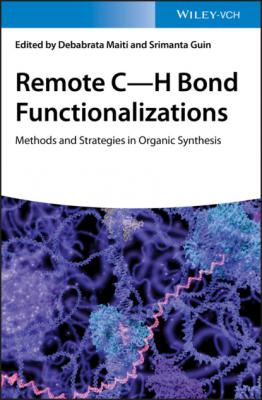Remote C-H Bond Functionalizations. Группа авторов
Читать онлайн.| Название | Remote C-H Bond Functionalizations |
|---|---|
| Автор произведения | Группа авторов |
| Жанр | Химия |
| Серия | |
| Издательство | Химия |
| Год выпуска | 0 |
| isbn | 9783527824144 |
Scheme 2.62 meta‐C–H functionalizations of phosphonates.
Source: Modified from Bera et al. [54].
Later in 2017, Maiti and coworkers achieved the meta‐C–H alkylation of benzylphosphonates by using a pyrimidine‐based template using allyl alcohols, leading to the formation of β‐aryl aldehydes and ketones (Scheme 2.63) [39]. Notably, the generality of this meta‐alkylation had been demonstrated in phenethylsulfonyl ester as well as phenethyl carbonyl scaffolds as discussed earlier. Moreover, meta‐C–H cyanation of benzylphosphonates was also achieved by using the same pyrimidine‐based template, albeit only two examples were disclosed [41].
Scheme 2.63 meta‐C–H alkylation of phosphonates.
Source: Modified from Bag et al. [39].
Phosphonates are useful synthons in the synthetic chemistry, since they could be transformed readily to the versatile alkenyl product by well‐established Horner–Wadsworth–Emmons reactions. And due to the importance of deuterium‐labeled compounds for pharmaceutical industry and reaction mechanistic studies, efficient direct deuteration methods would be very valuable. Recently, Yu, Dai, and coworkers developed palladium‐catalyzed meta‐selective C–H deuteration of benzylphosphonates by using a pyridine‐based directing template (Scheme 2.64) [19]. Notably, this method could be generally used for other substrates such as benzylsulfonates and benzyl alcohols via the practical ester linkage.
Scheme 2.64 meta‐C–H deuteration of phosphonates.
Source: Modified from Xu et al. [19].
2.3 Mechanistic Considerations
The mechanisms of the aforementioned template assisted meta‐C–H activation reactions are still not exactly very clear at present. However, detailed mechanistic investigations through computational and experimental mechanistic studies have been performed by such as the groups of Houk, Yu, and Wu, and the Maiti group to gain some hints of the reaction mechanism.
The representative template assisted meta‐C–H activation is olefination via Pd(II)/Pd(0) process with the nitrile‐based directing template. Thus, a tentative catalytic cycle could be proposed for this reaction (Scheme 2.65). The catalytic process proceeds through five major steps: C–H activation, olefin binding and alkene migratory insertion, β‐hydride elimination, reductive elimination, and re‐oxidation of the Pd‐catalyst. Computational study using density functional theory elucidated that the C–H activation step, which proceeds via a concerted metalation–deprotonation (CMD) pathway, was the rate‐ and regioselectivity‐determining step [55]. However, unlike the presentation in Scheme 2.65, it was found that the C–H activation with the nitrile‐based directing template occurred via a Pd–Ag heterodimeric transition state (Scheme 2.66). Moreover, the nitrile directing template coordinated with Ag an end‐on fashion rather than the Pd metal center. The Pd was then linked with Ag by the bridging acetate ligand and delivered to the meta‐C
Scheme 2.65 Proposed catalytic cycle for meta‐C–H olefination.
Scheme 2.66 Proposed transition state through computational study.
Subsequently, Houk, Yu, Wu, and coworkers revealed the dual roles of the amino acid ligand in improving reactivity and selectivity through mass spectrometry (MS) and DFT calculations [56]. It was found that the amino acid ligand aced as both a dianionic ligand and a proton acceptor, leading to the stabilization of the monomeric Pd complexes and serving as the internal base for proton abstraction through a CMD pathway.
Besides the MPAA ligand, the HFIP solvent is another key factor for most of the template assisted meta‐C–H activation reactions. Although the exact role of HFIP is unknown at present, Maiti and coworkers proposed that the solvent HFIP could act as a coordinating ligand in the early stage of the reaction to promote the reaction through experimental and computational investigation [40,54]. Moreover, they also found that the hydrogen‐bonding between HFIP and the pyrimidine‐based template was vital to decrease the basicity of the pyrimidine group and increase the π‐acidity of the Pd center based on nuclear magnetic resonance (NMR) studies [51].
2.4 Conclusion
Since 2012, the directing template approach has promoted a range of meta‐selective C–H activation reactions with several classes of substrate. Three major classes of directing templates have been engineered by recognition of the geometry and distance between the directing atom and the target meta‐C
